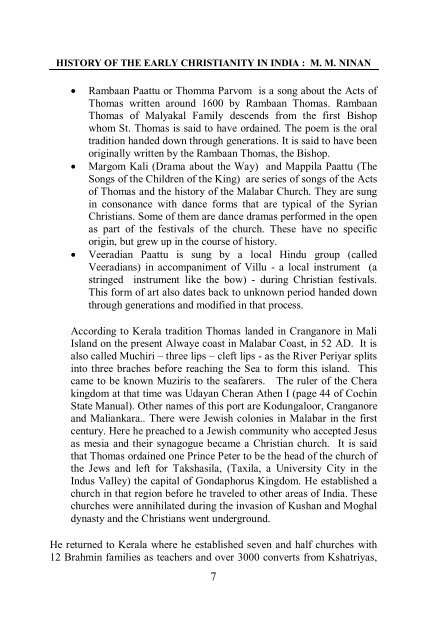History of Early Christianity in India
You also want an ePaper? Increase the reach of your titles
YUMPU automatically turns print PDFs into web optimized ePapers that Google loves.
HISTORY OF THE EARLY CHRISTIANITY IN INDIA : M. M. NINAN<br />
<br />
<br />
<br />
Rambaan Paattu or Thomma Parvom is a song about the Acts <strong>of</strong><br />
Thomas written around 1600 by Rambaan Thomas. Rambaan<br />
Thomas <strong>of</strong> Malyakal Family descends from the first Bishop<br />
whom St. Thomas is said to have orda<strong>in</strong>ed. The poem is the oral<br />
tradition handed down through generations. It is said to have been<br />
orig<strong>in</strong>ally written by the Rambaan Thomas, the Bishop.<br />
Margom Kali (Drama about the Way) and Mappila Paattu (The<br />
Songs <strong>of</strong> the Children <strong>of</strong> the K<strong>in</strong>g) are series <strong>of</strong> songs <strong>of</strong> the Acts<br />
<strong>of</strong> Thomas and the history <strong>of</strong> the Malabar Church. They are sung<br />
<strong>in</strong> consonance with dance forms that are typical <strong>of</strong> the Syrian<br />
Christians. Some <strong>of</strong> them are dance dramas performed <strong>in</strong> the open<br />
as part <strong>of</strong> the festivals <strong>of</strong> the church. These have no specific<br />
orig<strong>in</strong>, but grew up <strong>in</strong> the course <strong>of</strong> history.<br />
Veeradian Paattu is sung by a local H<strong>in</strong>du group (called<br />
Veeradians) <strong>in</strong> accompaniment <strong>of</strong> Villu - a local <strong>in</strong>strument (a<br />
str<strong>in</strong>ged <strong>in</strong>strument like the bow) - dur<strong>in</strong>g Christian festivals.<br />
This form <strong>of</strong> art also dates back to unknown period handed down<br />
through generations and modified <strong>in</strong> that process.<br />
Accord<strong>in</strong>g to Kerala tradition Thomas landed <strong>in</strong> Cranganore <strong>in</strong> Mali<br />
Island on the present Alwaye coast <strong>in</strong> Malabar Coast, <strong>in</strong> 52 AD. It is<br />
also called Muchiri – three lips – cleft lips - as the River Periyar splits<br />
<strong>in</strong>to three braches before reach<strong>in</strong>g the Sea to form this island. This<br />
came to be known Muziris to the seafarers. The ruler <strong>of</strong> the Chera<br />
k<strong>in</strong>gdom at that time was Udayan Cheran Athen I (page 44 <strong>of</strong> Coch<strong>in</strong><br />
State Manual). Other names <strong>of</strong> this port are Kodungaloor, Cranganore<br />
and Maliankara.. There were Jewish colonies <strong>in</strong> Malabar <strong>in</strong> the first<br />
century. Here he preached to a Jewish community who accepted Jesus<br />
as mesia and their synagogue became a Christian church. It is said<br />
that Thomas orda<strong>in</strong>ed one Pr<strong>in</strong>ce Peter to be the head <strong>of</strong> the church <strong>of</strong><br />
the Jews and left for Takshasila, (Taxila, a University City <strong>in</strong> the<br />
Indus Valley) the capital <strong>of</strong> Gondaphorus K<strong>in</strong>gdom. He established a<br />
church <strong>in</strong> that region before he traveled to other areas <strong>of</strong> <strong>India</strong>. These<br />
churches were annihilated dur<strong>in</strong>g the <strong>in</strong>vasion <strong>of</strong> Kushan and Moghal<br />
dynasty and the Christians went underground.<br />
He returned to Kerala where he established seven and half churches with<br />
12 Brahm<strong>in</strong> families as teachers and over 3000 converts from Kshatriyas,<br />
7


















